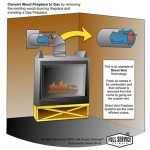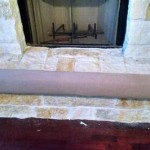How Ventless Gas Fireplaces Work: A Detailed Explanation
Ventless gas fireplaces, also known as vent-free gas fireplaces, offer an alternative to traditional wood-burning or vented gas fireplaces. Their primary appeal lies in their ability to operate without a chimney or extensive venting system, making them easier and more cost-effective to install in various locations. Understanding the mechanics behind how these fireplaces function is crucial for appreciating their advantages and limitations.
The operation of a ventless gas fireplace hinges on a carefully controlled combustion process, combined with advanced safety features designed to minimize the risks associated with burning gas indoors. These fireplaces are engineered to burn fuel—typically natural gas or propane—with a high level of efficiency, significantly reducing the production of harmful byproducts like carbon monoxide. However, the complete elimination of such byproducts is impossible, making the built-in safety mechanisms paramount.
Efficient Combustion and Oxygen Depletion Sensors
The core of a ventless gas fireplace's functionality lies in its burner system. This system is meticulously designed to ensure a clean and complete combustion process. The efficiency with which the gas is burned directly impacts the amount of pollutants released into the room. A properly functioning burner, coupled with an adequate supply of oxygen, minimizes the production of carbon monoxide, a colorless and odorless gas that can be dangerous at high concentrations.
The design of the burner often incorporates features that promote thorough mixing of gas and air. This can include specialized burner ports or baffles that create turbulence, ensuring that the gas molecules are fully exposed to oxygen during the combustion process. The result is a more complete burn, translating to fewer emissions.
Crucially, all ventless gas fireplaces are equipped with an Oxygen Depletion Sensor (ODS). This is the single most important safety feature. The ODS constantly monitors the oxygen levels in the room. As the name suggests, the ODS is designed to detect if the oxygen level in the room begins to decrease, a situation that could indicate incomplete combustion and a potential increase in carbon monoxide production. The ODS is thermocoupled to the fireplace's gas valve system, acting as a fail-safe. If the oxygen level drops below a pre-determined threshold (typically around 18%), the ODS triggers the gas valve to automatically shut off the gas supply to the burner. This action effectively extinguishes the flame and prevents further depletion of oxygen or the release of excessive carbon monoxide into the room.
It is vitally important that the ODS is not tampered with or disabled. This safety feature is the primary protection against carbon monoxide poisoning. Regular maintenance, including cleaning the burner and inspecting the ODS, is essential to ensuring its proper function and the overall safety of the fireplace.
The Role of Catalytic Converters
While efficient combustion and the ODS are fundamental components of a ventless gas fireplace, some models incorporate an additional layer of filtration through the use of a catalytic converter. Though not universally present in ventless gas fireplaces, a catalytic converter further reduces the levels of remaining pollutants in the exhaust gas emitted into the room.
A catalytic converter works by facilitating a chemical reaction that converts carbon monoxide into less harmful substances, primarily carbon dioxide and water vapor. The converter typically consists of a ceramic structure coated with a catalyst, such as platinum or palladium. As the exhaust gas passes through the converter, the catalyst promotes the oxidation of carbon monoxide, effectively transforming it into carbon dioxide.
The effectiveness of a catalytic converter depends on several factors, including the temperature of the exhaust gas and the efficiency of the catalyst. Over time, the catalyst can become less effective due to contamination or wear, requiring replacement. The presence of a catalytic converter contributes to cleaner emissions but it does not negate the need for proper ventilation and adherence to safety guidelines.
It's important to note that even with a catalytic converter, a ventless gas fireplace introduces combustion byproducts into the living space. While the converter minimizes the levels of harmful pollutants, it does not eliminate them entirely. Therefore, regular monitoring and maintenance of the fireplace, along with adequate ventilation, remain essential for safe operation.
The use of a catalytic converter is an added measure of safety, particularly for individuals who are more sensitive to air quality, such as those with respiratory conditions. However, it should not be considered a replacement for the primary safety features inherent in ventless gas fireplaces, such as the ODS and the burner design optimized for efficient combustion.
Installation Requirements and Ventilation Considerations
Despite the fact that ventless gas fireplaces do not require a chimney, they still have specific installation requirements that must be followed to ensure safe and efficient operation. These requirements typically include minimum room size restrictions, as the fireplace consumes oxygen during operation. Manufacturers specify the minimum cubic footage of the room based on the BTU (British Thermal Unit) output of the fireplace.
The minimum room size requirement is directly related to the amount of oxygen the fireplace will consume during operation. A larger fireplace with a higher BTU output will require a larger room to ensure that the oxygen level does not drop below safe levels. Failing to adhere to these requirements can increase the risk of incomplete combustion and the build-up of carbon monoxide.
In addition to room size, ventilation is a critical consideration, even for ventless models. While the fireplace is designed to burn cleanly, it still releases combustion byproducts into the room. Opening a window or door slightly can provide necessary air exchange and prevent the accumulation of these byproducts. Many local building codes mandate a source of fresh air ventilation for rooms with ventless gas appliances.
Furthermore, the location of the fireplace within the room is important. It should be placed away from flammable materials, such as curtains, furniture, and rugs. Clearances specified by the manufacturer must be strictly adhered to. Proper installation also includes ensuring that the gas supply is properly connected and that all connections are leak-tested.
Local building codes often dictate specific requirements for the installation of ventless gas fireplaces. It is imperative to consult with local authorities and obtain any necessary permits before installation. Some jurisdictions may prohibit the use of ventless gas fireplaces altogether due to concerns about air quality and safety. A qualified technician must perform the gas line connection and ensure that the appliance is operating safely and efficiently.
In summary, ventless gas fireplaces operate by employing a combination of efficient combustion design, the use of oxygen depletion sensors, and in some cases, catalytic converters. These features are designed to minimize the risk of carbon monoxide poisoning and ensure that emissions are within acceptable levels. However, it is still crucial to adhere to all installation requirements, ensure adequate ventilation, and regularly maintain the fireplace to ensure safe and reliable operation. A properly installed and maintained ventless gas fireplace can provide supplemental heat and ambiance without the need for a chimney, offering a practical alternative to traditional fireplaces.
.aspx?strip=all)
Ventless Fireplaces Explained Safety Of Vent Free Fires

Are Vent Free Gas Fireplaces Safe Ventless

Vented Vs B Vent Direct Free Dixie S

Vented Vs Ventless Gas Fireplace Logs

How To Select And Install A Gas Fireplace Log Set Fireplaces Direct Learning Center

Gas Fireplaces Direct Vent Vs Free Fine Homebuilding

Vented Vs Ventless Gas Logs What S The Difference
:max_bytes(150000):strip_icc()/ventless-gas-fireplaces-4160746-hero-f9d4bdcd9bd446eb84406de306f790ba.jpg?strip=all)
How To Pick Out A Ventless Gas Fireplace

What You Need To Know About Gas Fireplace Logs Fireplaces Direct Learning Center

Considering A Ventless Gas Fireplace Here S What You Need To Know Bob Vila
Related Posts








